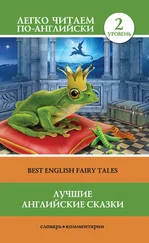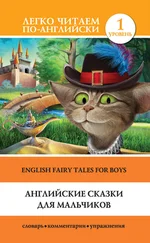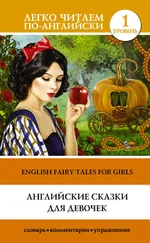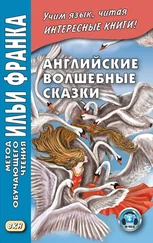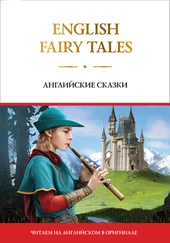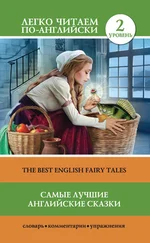Joseph Jacobs - More English Fairy Tales
Здесь есть возможность читать онлайн «Joseph Jacobs - More English Fairy Tales» весь текст электронной книги совершенно бесплатно (целиком полную версию без сокращений). В некоторых случаях можно слушать аудио, скачать через торрент в формате fb2 и присутствует краткое содержание. Год выпуска: 1894, Жанр: Сказка, на английском языке. Описание произведения, (предисловие) а так же отзывы посетителей доступны на портале библиотеки ЛибКат.
- Название:More English Fairy Tales
- Автор:
- Жанр:
- Год:1894
- ISBN:нет данных
- Рейтинг книги:5 / 5. Голосов: 1
-
Избранное:Добавить в избранное
- Отзывы:
-
Ваша оценка:
- 100
- 1
- 2
- 3
- 4
- 5
More English Fairy Tales: краткое содержание, описание и аннотация
Предлагаем к чтению аннотацию, описание, краткое содержание или предисловие (зависит от того, что написал сам автор книги «More English Fairy Tales»). Если вы не нашли необходимую информацию о книге — напишите в комментариях, мы постараемся отыскать её.
Illustrated by John D. Batten.
Book text and illustrations are taken from the site www.gutenberg.org
More English Fairy Tales — читать онлайн бесплатно полную книгу (весь текст) целиком
Ниже представлен текст книги, разбитый по страницам. Система сохранения места последней прочитанной страницы, позволяет с удобством читать онлайн бесплатно книгу «More English Fairy Tales», без необходимости каждый раз заново искать на чём Вы остановились. Поставьте закладку, и сможете в любой момент перейти на страницу, на которой закончили чтение.
Интервал:
Закладка:
LXXIV. KING O’ CATS
Source. —I have taken a point here and a point there from the various English versions mentioned in the next section.
I have expanded the names, so as to make a jingle from the Dildrum and Doldrum of Hartland.
Parallels. —Five variants of this quaint legend have been collected in England: (1) Halliwell, Pop. Rhymes , 167, “Molly Dixon”; (2) Choice Notes—Folk-Lore , p. 73, “Colman Grey”; (3) Folk-Lore Journal , ii., 22, “King o’ the Cats”; (4) Folk-Lore—England (Gibbings), “Johnny Reed’s Cat”; (5) Hartland and Wilkinson, Lancashire Legends , p. 13, “Dildrum Doldrum.” Sir F. Palgrave gives a Danish parallel; cf. Halliwell, l.c.
Remarks. —An interesting example of the spread and development of a simple anecdote throughout England. Here again we can scarcely imagine more than a single origin for the tale which is, in its way, as weird and fantastic as E.A. Poe.
LXXV. TAMLANE
Source. —From Scott’s Minstrelsy , with touches from the other variants given by Prof. Child in his Eng. and Scotch Ballads , i., 335-58.
Parallels. —Prof. Child gives no less than nine versions in his masterly edition, l.c. , besides another fragment “Burd Ellen and Young Tamlane,” i., 258. He parallels the marriage of Peleus and Thetis in Apollodorus III., xiii., 5, 6, which still persists in modern Greece as a Cretan ballad.
Remarks. —Prof. Child remarks that dipping into water or milk is necessary before transformation can take place, and gives examples, l.c. , 338, to which may be added that of Catskin (see Notes infra ). He gives as the reason why the Elf-queen would have “ta’en out Tamlane’s two grey eyne,” so that henceforth he should not be able to see the fairies. Was it not rather that he should not henceforth see Burd Janet?—a subtle touch of jealousy. On dwelling in fairyland Mr. Hartland has a monograph in his Science of Fairy Tales , pp. 161-254.
LXXVI. THE STARS IN THE SKY
Source. —Mrs. Balfour’s old nurse, now in New Zealand. The original is in broad Scots, which I have anglicised.
Parallels. —The tradition is widespread that at the foot of the rainbow treasure is to be found; cf. Mr. John Payne’s “Sir Edward’s Questing” in his Songs of Life and Death .
Remarks. —The “sell” at the end is scarcely after the manner of the folk, and various touches throughout indicate a transmission through minds tainted with culture and introspection.
LXXVII. NEWS!
Source. —Bell’s Speaker .
Parallels. —Jacques de Vitry, Exempla , ed. Crane, No. ccv., a servant being asked the news by his master returned from a pilgrimage to Compostella, says the dog is lame, and goes on to explain: “While the dog was running near the mule, the mule kicked him and broke his own halter and ran through the house, scattering the fire with his hoofs, and burning down your house with your wife.” It occurs even earlier in Alfonsi’s Disciplina Clericalis , No. xxx., at beginning of the twelfth century, among the Fabliaux , and in Bebel, Werke , iii., 71, whence probably it was reintroduced into England. See Prof. Crane’s note ad loc.
Remarks. —Almost all Alfonsi’s exempla are from the East. It is characteristic that the German version finishes up with a loss of honour, the English climax being loss of fortune.
LXXVIII. PUDDOCK, MOUSIE, AND RATTON
Source. —Kirkpatrick Sharpe’s Ballad Book , 1824, slightly anglicised.
Parallels. —Mr. Bullen, in his Lyrics from Elizabethan Song Books , p. 202, gives a version, “The Marriage of the Frog and the Mouse,” from T. Ravenscroft’s Melismata , 1611. The nursery rhyme of the frog who would a-wooing go is clearly a variant of this, and has thus a sure pedigree of three hundred years; cf. “Frog husband” in my List of Incidents, or notes to “The Well of the World’s End” (No. xli.).
LXXIX. LITTLE BULL-CALF
Source. — Gypsy Lore Journal , iii., one of a number of tales told “In a Tent” to Mr. John Sampson. I have respelt and euphemised the bladder.
Parallels. —The Perseus and Andromeda incident is frequent in folk-tales; see my List of Incidents sub voce “Fight with Dragon.” “Cheese squeezing,” as a test of prowess, is also common, as in “Jack the Giant Killer” and elsewhere (Köhler, Jahrbuch , vii., 252).
LXXX. THE WEE WEE MANNIE
Source. —From Mrs. Balfour’s old nurse. I have again anglicised.
Parallels. —This is one of the class of accumulative stories like The Old Woman and her Pig (No. iv.). The class is well represented in these isles.
LXXXI. HABETROT AND SCANTLIE MAB
Source. —Henderson’s Folk-Lore of Northern Counties , pp. 258-62 of Folk-Lore Society’s edition. I have abridged and to some extent rewritten.
Parallels. —This in its early part is a parallel to the Tom Tit Tot , which see. The latter part is more novel, and is best compared with the Grimms’ Spinners .
Remark. —Henderson makes out of Habetrot a goddess of the spinning-wheel, but with very little authority as it seems to me.
LXXXII. OLD MOTHER WIGGLE WAGGLE
Source. —I have inserted into Halliwell’s version one current in Mr. Batten’s family, except that I have substituted “Wiggle-Waggle” for “Slipper-Slopper.” The two versions supplement one another.
Remarks. —This is a pure bit of animal satire, which might have come from a rural Jefferies with somewhat more of wit than the native writer.
LXXXIII. CATSKIN
Source. —From the chap-book reprinted in Halliwell I have introduced the demand for magic dresses from Chambers’s Rashie Coat , into which it had clearly been interpolated from some version of Catskin.
Parallels. —Miss Cox’s admirable volume of variants of Cinderella also contains seventy-three variants of Catskin , besides thirteen “indeterminate” ones which approximate to that type. Of these eighty-six, five exist in the British Isles, two chap-books given in Halliwell and in Dixon’s Songs of English Peasantry , two by Campbell, Nos. xiv. and xiv a , “The King who Wished to Marry his Daughter,” and one by Kennedy’s Fireside Stories , “The Princess in the Catskins.” Goldsmith knew the story by the name of “Catskin,” as he refers to it in the Vicar . There is a fragment from Cornwall in Folk-Lore , i., App. p. 149.
Remarks. — Catskin, or the Wandering Gentlewomen , now exists in English only in two chap-book ballads. But Chambers’s first variant of Rashie Coat begins with the Catskin formula in a euphemised form. The full formula may be said to run in abbreviated form— Death-bed promise—Deceased wife’s resemblance marriage test—Unnatural father (desiring to marry his own daughter)— Helpful animal—Counter tasks—Magic dresses—Heroine flight—Heroine disguise—Menial heroine—Meeting-place—Token objects named—Threefold flight—Lovesick prince—Recognition ring—Happy marriage . Of these the chap-book versions contain scarcely anything of the opening motifs . Yet they existed in England, for Miss Isabella Barclay, in a variant which Miss Cox has overlooked ( Folk-Lore , i., l.c. ), remembers having heard the Unnatural Father incident from a Cornish servant-girl. Campbell’s two versions also contain the incident, from which one of them receives its name. One wonders in what form Mr. Burchell knew Catskin, for “he gave the [Primrose] children the Buck of Beverland, [3] Who knows the Buck of Beverland nowadays?
with the history of Patient Grissel, the adventures of Catskin and the Fair Rosamond’s Bower” ( Vicar of Wakefield , 1766, c. vi.). Pity that “Goldy” did not tell the story himself, as he had probably heard it in Ireland, where Kennedy gives a poor version in his Fireside Stories .
Интервал:
Закладка:
Похожие книги на «More English Fairy Tales»
Представляем Вашему вниманию похожие книги на «More English Fairy Tales» списком для выбора. Мы отобрали схожую по названию и смыслу литературу в надежде предоставить читателям больше вариантов отыскать новые, интересные, ещё непрочитанные произведения.
Обсуждение, отзывы о книге «More English Fairy Tales» и просто собственные мнения читателей. Оставьте ваши комментарии, напишите, что Вы думаете о произведении, его смысле или главных героях. Укажите что конкретно понравилось, а что нет, и почему Вы так считаете.

